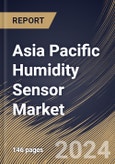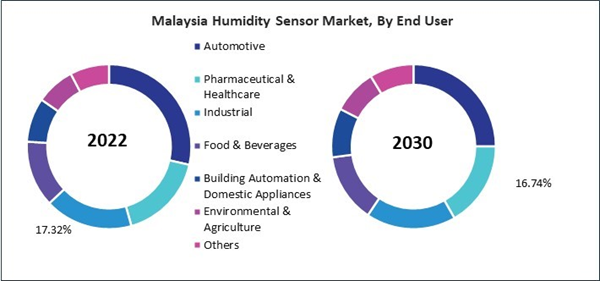These sensors play a critical role in regulating HVAC systems, ensuring efficient air conditioning and defrosting functionalities in response to changing environmental conditions. Moreover, humidity sensors contribute to advanced driver assistance systems (ADAS) by providing accurate environmental data for optimal performance of automated driving features and sensor fusion technologies. Therefore, the India market utilized 52.1 thousand units’ of humidity sensor in Automotive in 2022.
The China market dominated the Asia Pacific Humidity Sensor Market by Country in 2022, and would continue to be a dominant market till 2030; thereby, achieving a market value of $225.6 million by 2030. The Japan market is registering a CAGR of 8.8% during (2023 - 2030). Additionally, The India market would showcase a CAGR of 10.3% during (2023 - 2030).
Aerospace and aviation industries utilize humidity sensors to monitor and control cabin conditions in aircraft. Maintaining optimal humidity levels is essential for passenger comfort and preventing issues such as condensation and corrosion within the aircraft. In semiconductor manufacturing, where precise control of environmental conditions is critical, humidity sensors ensure that the fabrication processes occur in controlled atmospheres.
Moreover, maintaining specific humidity levels is crucial for preventing defects and ensuring the quality of semiconductor components. In addition, the food and beverage industry relies on humidity sensors to maintain optimal conditions in storage facilities and production environments. Controlling humidity helps preserve the freshness and quality of perishable goods, preventing spoilage and mold growth.
India has diverse climatic zones, ranging from arid regions to humid coastal areas. Humidity sensors are essential in adapting agricultural practices to these varying climates, allowing farmers to make informed decisions based on localized environmental conditions. The agriculture sector in India is highly dependent on the monsoon. Therefore, the rising consumer electronics and agriculture sectors in Asia Pacific can assist in the growth of the regional humidity sensor market.
Based on Type, the market is segmented into Absolute, Relative and Others. Based on End User, the market is segmented into Automotive, Pharmaceutical & Healthcare, Industrial, Food & Beverages, Building Automation & Domestic Appliances, Environmental & Agriculture and Others. Based on countries, the market is segmented into China, Japan, India, South Korea, Singapore, Malaysia, and Rest of Asia Pacific.
List of Key Companies Profiled
- General Electric Company
- Sensirion AG
- TE Connectivity Ltd.
- Honeywell International, Inc.
- Continental AG
- Infineon Technologies AG
- Robert Bosch GmbH
- Sensata Technologies Holdings PLC
- Omron Corporation
- Hitachi, Ltd.
Market Report Segmentation
By Type (Volume, Thousand Units, USD Billion, 2019-2030)- Absolute
- Relative
- Others
- Automotive
- Pharmaceutical & Healthcare
- Industrial
- Food & Beverages
- Building Automation & Domestic Appliances
- Environmental & Agriculture
- Others
- China
- Japan
- India
- South Korea
- Taiwan
- Malaysia
- Rest of Asia Pacific
Table of Contents
Companies Mentioned
- General Electric Company
- Sensirion AG
- TE Connectivity Ltd.
- Honeywell International, Inc.
- Continental AG
- Infineon Technologies AG
- Robert Bosch GmbH
- Sensata Technologies Holdings PLC
- Omron Corporation
- Hitachi, Ltd.









